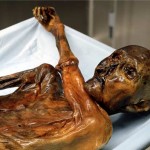 The Tyrolean Iceman known as Otzi died in the Alps 5,000 years ago, but despite his relative youth, scientists have discovered that he has no genetic descendants.
The Tyrolean Iceman known as Otzi died in the Alps 5,000 years ago, but despite his relative youth, scientists have discovered that he has no genetic descendants.
Earlier study of the DNA showed that he belonged to the lineage, or “subhaplogroup,” known as K1. About 8% of modern Europeans belong to the K haplogroup, meaning that they share a common ancestor, and that group is divided into two “subhaplogroups,” K1 and K2. The K1 haplogroup, in turn, can be divided into three clusters.
In the new study, the researchers took advantage of advanced genome-sequencing technologies to shed more light on the Iceman’s genetics. They sequenced his entire mitochondrial genome and compared that sequence to other published human mitochondrial DNA sequences to construct his evolutionary (or phylogenetic) family tree.
“The surprise came when we found that the lineage of the Iceman did not fit any of the three known K1 clusters,” Rollo said. His team has informally named the newly discovered branch on the human family tree “Otzi’s branch.”
This is unexpected news. He’s not all that old, really. You’d think there’d be some direct genetic link between him and modern Europeans, but nope.
It seems he was a member of a genetic group that is extinct now, or at least so rare that scientists have yet to find it.
I am really surprised. Wasn’t he the guy that had some strange medicine on him? A de-wormer of sorts? I can’t remember.
great post!
He had a type of mushroom with him which is known to have antibacterial properties, but I don’t know if it’s a dewormer too.
Scientists actually found whipworm in his intestines, so could be.
Oh, and thank you! :thanks:
Honestly, I’m not THAT surprised. The black plague came after Otzi, and it did a “fair bit” of damage to Europe. If the K1 haplotype was as rare then, as it is now (~8%) then it’s possible that a branch or two of that type was wiped out during that period.
That makes sense. I wonder how many other haplotypes got buboes and died.
Good question. Sounds like a very interesting, and potentially useful, project. I’m not sure if the Bog People found in the sphagnum bogs have intact DNA which can be haplotyped, but if they can, it would serve as one source of testable DNA.
Oh good idea. There are all kinds of different natural mummies out there that might have testable DNA. A historical European genome project could tell us so much about the history of the continent, not to mention its scientific/medical, value, like that thing about the gene variant that protects from HIV.
Woah, doing school project on Otzi :skull: , really amazing. 😉 Needed research. That is interestng… but kinda dissapointed.. 😥 was kinda hoping there could be a chance where i was realted to Otzi lol :love:
Also, loving the smileys!! :chicken:
Yeah, hahaha 😆 anyway, good job on the site!!
Go OTZI!! :boogie:
:hattip:
Did you find this entry about the HD pictures of Otzi? That might be useful for your school project.
Glad you like the smilies. 🙂
My family has the same G2a4 DNA on my dads side:
che schifo poveretto sembra un pollo a rosto.. :skull: :skull: :skull:
oi
:love: